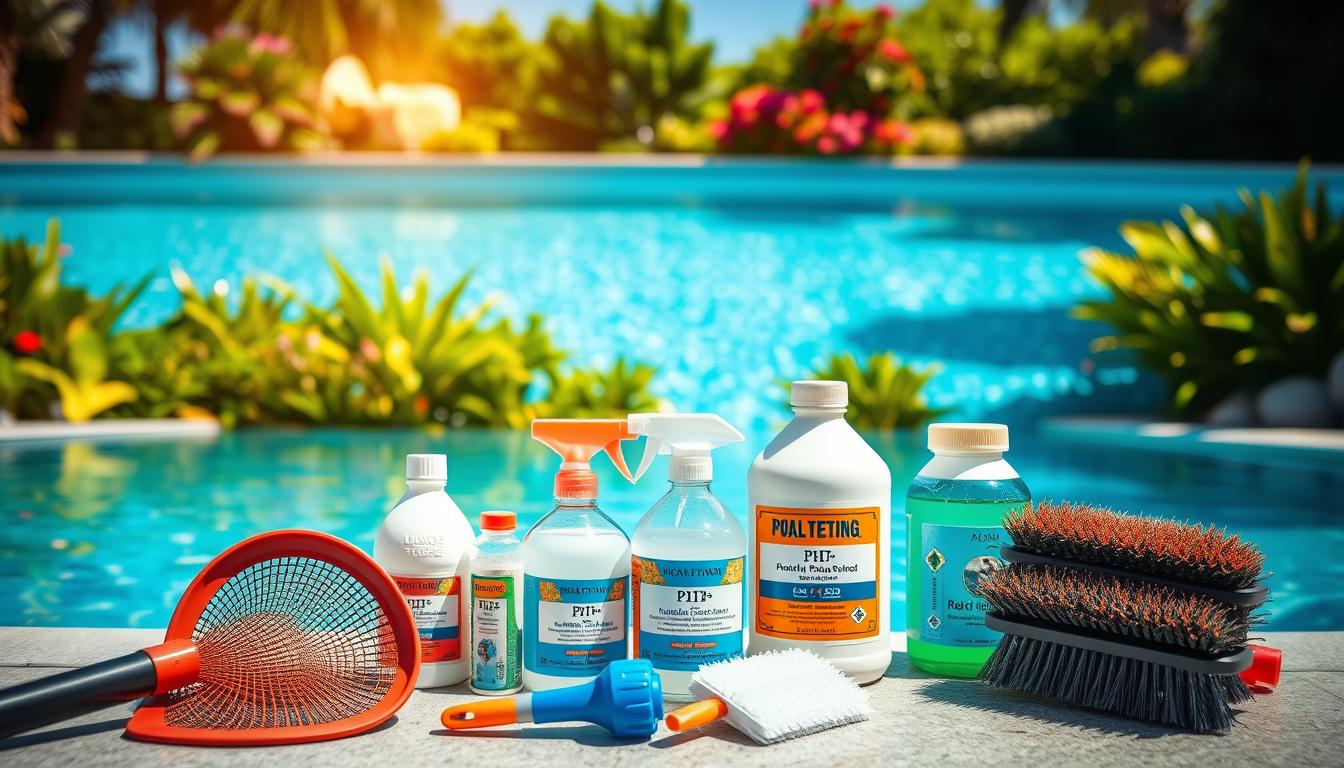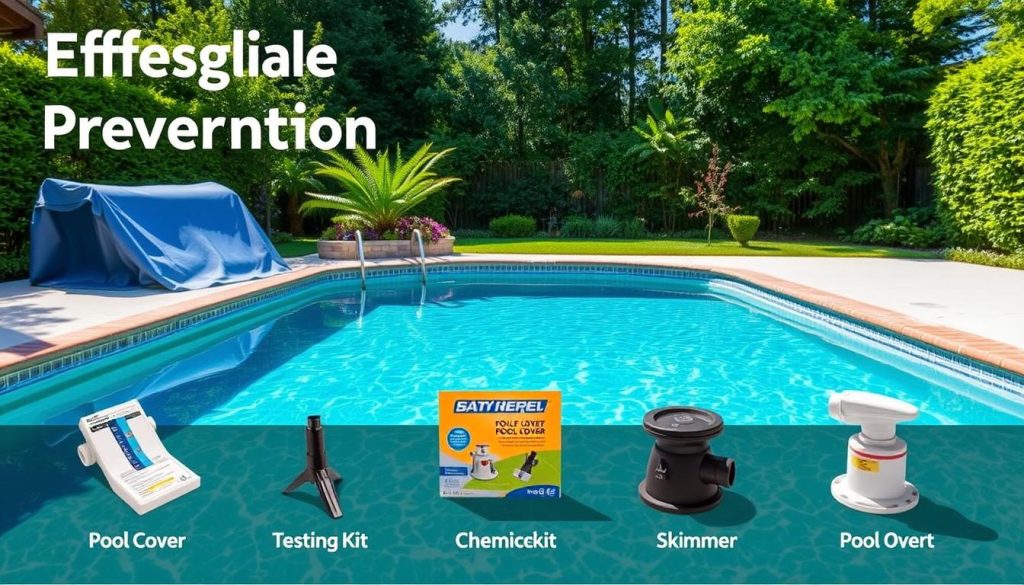
Summer heat makes backyard pools a refreshing oasis. But algae can quickly turn clear water into a green mess. Preventing algae growth is vital for a clean swimming environment.
Understanding what causes algae is the first step. Warm, sunny water with low chlorine levels creates ideal conditions for algae growth.
Poor pool maintenance leads to algae problems. Unbalanced water chemistry, low chlorine, dirty filters, and poor circulation are common causes. Effective cleaning and proper chemistry can prevent algae growth.
This article explores pool maintenance strategies to prevent algae. We’ll discuss different types of algae and expert tips for crystal-clear water. You’ll learn about chlorine levels, pH testing, filtration, and pool shocking.
With these tools, you can maintain a sparkling pool all season. Your pool will be the envy of the neighborhood!
Understanding Algae Formation and Types
Keeping a pool clear requires knowing about pool algae types and their growth conditions. Algae thrive in warm water, specific pH levels, and poor circulation. They reproduce quickly in temperatures between 70°F and 90°F.
Maintaining a pH balance of 7.2 to 7.8 helps control algae growth. Regular pool maintenance is key to preventing algae formation.
Green Algae: The Most Common Culprit
Green algae is the most common type in swimming pools, especially in North Texas. It thrives in pools with poor circulation and filtration. This algae can make water cloudy or green.
Green algae spreads fast, covering pool surfaces within 24 hours if not treated. Regular cleaning and proper chemical balance help prevent its growth.
Yellow Algae (Mustard Algae): A Slimy Menace
Yellow algae, also called mustard algae, is less common but harder to remove. It resists chlorine and grows in shaded pool areas. This algae has a slimy texture and looks like sand or dirt.
Identifying and treating mustard algae quickly is important. Special chemicals and thorough brushing are often needed to eliminate it.
Black Algae: The Stubborn Survivor
Black algae is actually a type of cyanobacteria that behaves like algae. It’s the toughest to eliminate and forms deep-rooted colonies on pool surfaces. Black algae resist chlorine and need aggressive treatment methods.
This type is more common in coastal areas and rare in Dallas-Fort Worth. Thorough scrubbing and high chlorine levels are needed to remove it.
Understanding pool algae types and their growth conditions is crucial for effective prevention and treatment. Proper water chemistry, circulation, and filtration help keep pools clean and inviting.
| Algae Type | Characteristics | Growth Conditions |
|---|---|---|
| Green Algae | Most common, causes cloudy or green water | Poor circulation and filtration |
| Yellow Algae (Mustard Algae) | Yellowish-brown, slimy texture, chlorine-resistant | Shaded areas of the pool |
| Black Algae | Stubborn, deep-rooted colonies, chlorine-resistant | Concrete or plaster surfaces, coastal areas |
Effective Algae Prevention Strategies
Keeping algae out of our pools is key for a clean, safe swim. A solid prevention plan ensures crystal-clear water. Let’s explore ways to stop algae growth in its tracks.

Shock Treatment: Superchlorinating Your Pool
Regular pool shock treatments are a powerful algae deterrent. They eliminate contaminants and create a hostile environment for algae. Follow the maker’s instructions for best results.
Algaecide Application: An Extra Layer of Protection
Quality algaecides offer added defense against algae growth. They disrupt algae’s life cycle, making pool maintenance easier. Choose an algaecide that suits your pool type.
Always stick to the recommended application guidelines. This ensures maximum effectiveness and safety for swimmers.
Routine Brushing and Skimming: Disrupting Algae Growth
Brushing pool walls and skimming the surface helps prevent algae buildup. This simple task makes it harder for algae to take hold. Focus on corners, steps, and other tricky spots.
Proper Filtration and Circulation: Keeping Water Moving
Good filtration and circulation are vital to prevent stagnant water. Keep your filtration system in top shape. Clean or replace filters as needed.
Run the pump long enough each day. This keeps water moving and makes it tough for algae to grow.
Sunlight Control: Limiting Algae’s Fuel Source
Too much sun can boost algae growth. Use pool covers when the pool’s not in use. This cuts down on sunlight and helps control algae.
Covers also save water and keep temperatures steady. It’s a win-win for pool maintenance.
| Prevention Strategy | Benefits | Frequency |
|---|---|---|
| Shock Treatment | Eliminates organic contaminants, creates inhospitable environment for algae | Weekly or as needed |
| Algaecide Application | Disrupts algae growth and reproduction, provides extra protection | Weekly or as recommended |
| Brushing and Skimming | Removes debris, agitates water, disrupts algae growth | Daily or every other day |
| Filtration and Circulation | Prevents stagnant water, keeps water moving, reduces algae risk | Run pump daily for adequate duration |
| Sunlight Control | Limits sunlight penetration, reduces algae growth, conserves water | Use pool covers during inactivity |
By implementing these effective algae prevention strategies, we can enjoy a clean, clear, and inviting swimming pool all season long.
How to Keep Pool from Turning Green with Robotic Pool Cleaners
Robotic pool cleaners help prevent algae growth in swimming pools. They remove debris and contaminants that algae feed on. Their advanced filters capture fine particles, including algae spores, reducing bloom chances.
Many cleaners have powerful brushes that scrub off algae and biofilm. This physical removal is key to stopping algae growth. Regular use can lower the need for chemicals, benefiting both the environment and swimmers.
These devices constantly circulate water, preventing algae spores from settling. This disrupts the algae life cycle, reducing bloom risks. Investing in a robotic cleaner, like the Maytronics Dolphin series, can transform pool maintenance.
With minimal effort, these cleaners remove debris and scrub surfaces effectively. The result is a cleaner, healthier pool with sparkling, crystal-clear water for everyone to enjoy.







